Who Painted Some of the Very First Nonobjective Paitings in Art History
Imagine a painting composed of squares, lines, and but geometric motifs that seem to come from some other world, far removed from our ain understanding of naturally occurring forms and objects. This is only Non-Objective art, from this earth, which is what we will explore in this article along with some Non-Objective art examples.
Table of Contents
- 1 What Is Non-Objective Art?
- 1.1 A Non-Objective Art Definition
- 1.ii Where Did the Term "Non-Objective" Start?
- 2 Not-Objective Art Examples
- 2.ane Expressionism: Wassily Kandinsky (1866 – 1944)
- 2.2 Suprematism: Kazimir Malevich (1879 – 1935)
- two.3 Neo-Plasticism: Piet Mondrian (1872 – 1944)
- 2.4 Orphism: Sonia Delaunay (1885 – 1979)
- 2.v Hard-Border Painting: Frank Stella (1936 to Present)
- three A Thing of Formality
- 4 Oft Asked Questions
- 4.ane What Is Non-Objective Art?
- 4.ii What Is the Difference Between Non-Objective Art and Abstract Art?
- 4.three What Are Not-Objective Art Movements?
What Is Non-Objective Fine art?
Non-Objective art vs Abstract art often become together, just it can also exist disruptive to understand. Is Non-Objective art Abstruse art? Some sources say information technology is a form or style within the category of Abstract art, others say it is not synonymous with Abstract art, and others say it is Abstract art – in that location is a thin line between all of the to a higher place.
Below, we hash out the Non-Objective Art definition further, including its origins.
A Non-Objective Art Definition
Non-Objective art is also termed geometric abstraction. According to the definition provided by Tate, it is defined equally "a blazon of abstract art that is usually, simply not always, geometric and aims to convey a sense of simplicity and purity".
If we too wait at the definition Tate offers for Abstruse fine art, we volition take a better understanding of the non-objective. Abstruse art is defined equally art "that does non endeavour to represent an accurate depiction of a visual reality but instead uses shapes, colours, forms and gestural marks to achieve its outcome".
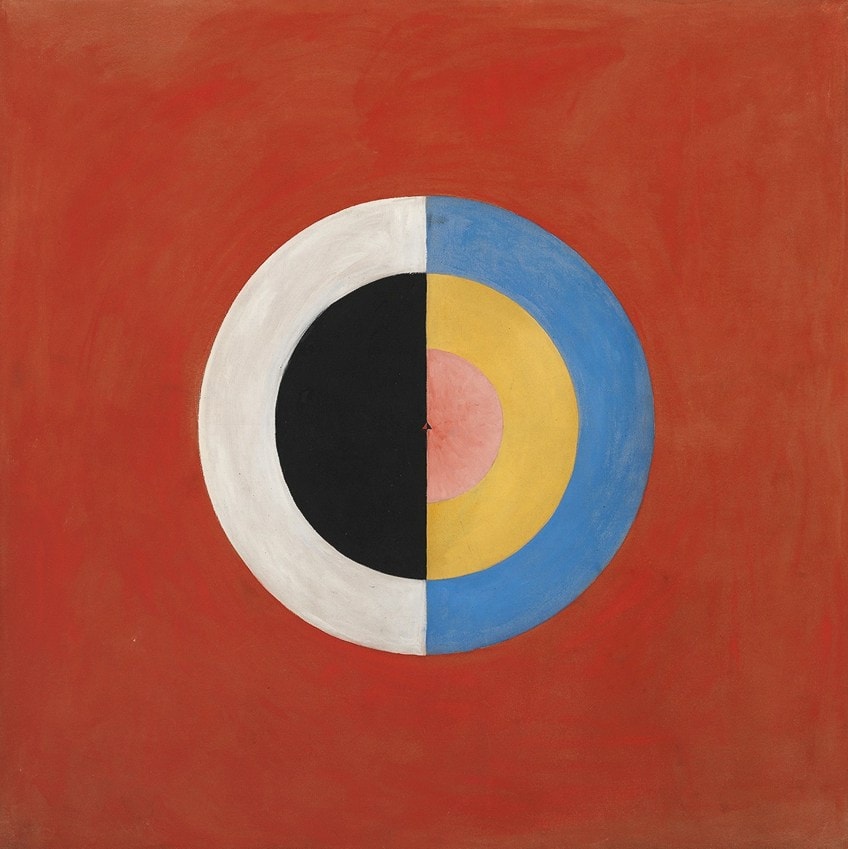 Swan (1915) by Hilma af Klint;Hilma af Klint, Public domain, via Wikimedia Commons
Swan (1915) by Hilma af Klint;Hilma af Klint, Public domain, via Wikimedia Commons
Indeed, it makes more than sense that Not-Objective fine art is a class of Abstract art, where there are no representational qualities or likenesses to reality; it is completely non-representational. Thus, it is also referred to as geometric abstraction considering information technology consists of geometric compositional motifs.
Abstract fine art will all the same have some resemblance to reality, although it will not exist an "accurate depiction" like we come across from Greek art, every bit an case, where artists followed the philosophical ideals of mimesis, meaning "to imitate". This was in the context of imitating nature or reality.
Where Did the Term "Not-Objective" Kickoff?
The Russian Constructivist, Alexander Rodchenko, showtime introduced the term, Non-Objective, when he presented several of his paintings from his Black on Black series, for example, Non-Objective Painting No 80 (1918). Rodchenko co-founded the fine art move in 1915 forth with fellow creative person Vladimir Tatlin. Constructivism equally a blazon of Abstruse art motion focused on the "structure" of art instead of the formal compositional qualities that create fine art.
Art was meant to be constructs of modern manufacture and serve utilitarian (functional) purposes, and non so much deeper reflections and expressions of inner emotional states.
Rodchenko's Black on Black serial was believed to be in response to the artwork by Kazimir Malevich, namely his Black Foursquare (1915). It could accept also been a play on Malevich'due south White on White (1918). Malevich was the founder of the preceding, and concurrent to Constructivism, an art movement chosen Suprematism. He founded it in 1913 while withal beingness involved in producing artworks with a Cubo-Futurist style, of which the exhibition, The Concluding Futurist Exhibition of Paintings 0,10, ushered in the new style of Suprematism, which included Malevich's Black Square.
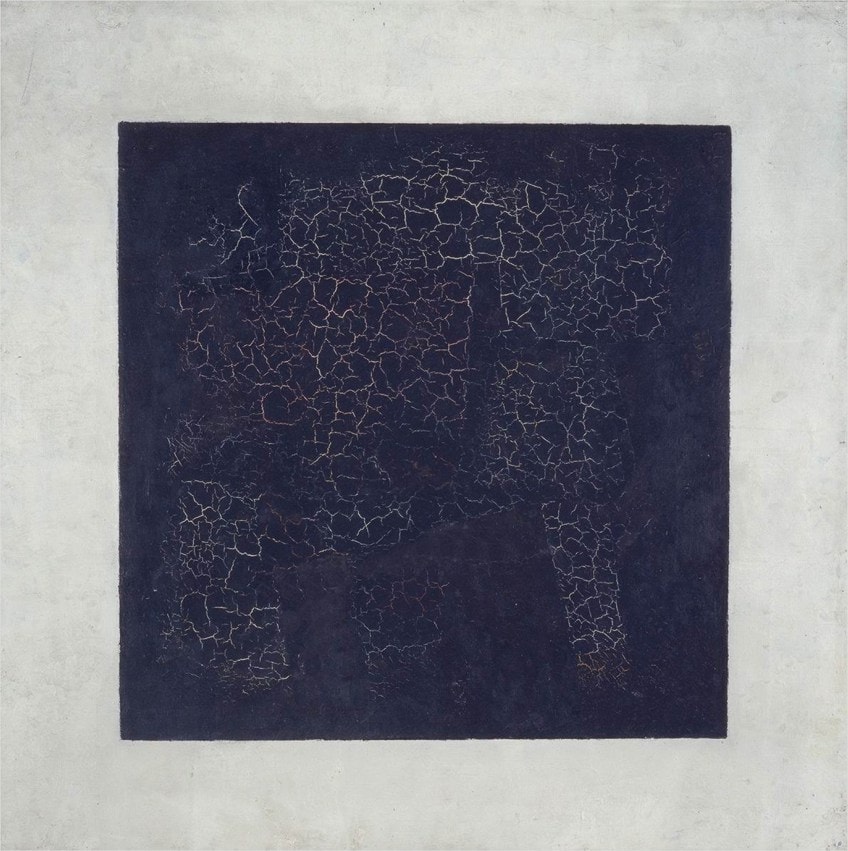 Black Foursquare (Black Suprematic Square) (1915) by Kazimir Malevich;Kazimir Malevich, Public domain, via Wikimedia Commons
Black Foursquare (Black Suprematic Square) (1915) by Kazimir Malevich;Kazimir Malevich, Public domain, via Wikimedia Commons
The exhibition was held in 1915 by the Dobychina Art Bureau in Petrograd, Russia. Malevich also wrote the accompanying text or manifesto as information technology also referred to, From Cubism and Futurism to Suprematism in Art (1915). In 1927 he as well utilized the term "non-objective" in his publication titled, The Non-Objective Earth (1927).
A famous quote from the above-mentioned text explains some of the core tenets of Suprematism and that it is related to "pure feeling" and the "visual phenomena" becoming somewhat "meaningless". They further explicate that feeling is the almost of import "apart from the surroundings in which it is called forth".
It was a movement all about going dorsum to the fundamentals of form, a "new realism" as Malevich declared it. It was nearly the "supremacy of pure feeling or perception in the pictorial arts". It was the complete opposite of Constructivism and sought to draw a grade as it was, in other words, it relied on the formal elements of painting, for example, color, line, shape, and so forth.
However, there was another part to Malevich'due south "new realism" and that was tied to a deeper meaning beyond the reality we see. Some sources as well advise it tied in with the spiritual aspects of art. In fact, Malevich was influenced by the esoteric philosophies of the Russian mystics P.D. Ouspensky and Georges Gurdjieff.
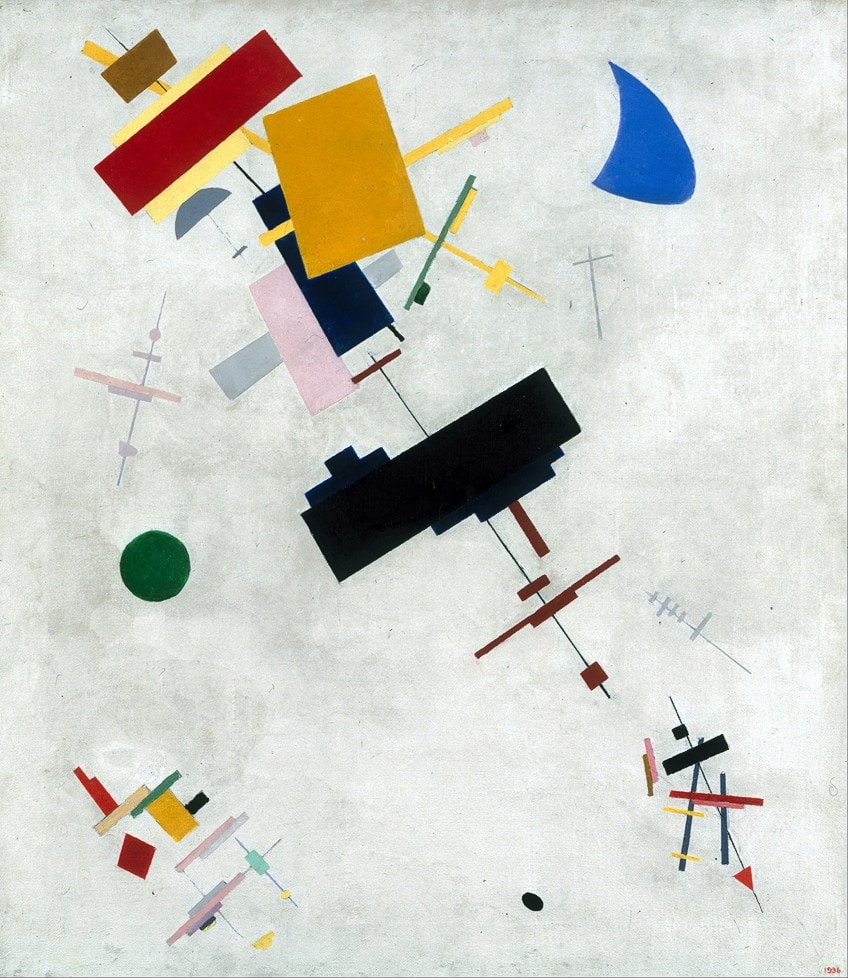 Suprematism (1915) by Kazimir Malevich; Kazimir Malevich, Public domain, via Wikimedia Commons
Suprematism (1915) by Kazimir Malevich; Kazimir Malevich, Public domain, via Wikimedia Commons
Suprematism was an important art movement in the world of not-objective painting, it ushered in new ways of seeing art and influenced many artists along the style in the Modern era. Information technology was non just Malevich who was considered a pioneer of non-objective, or otherwise, non-representational, art.
Artists like Wassily Kandinsky and Piet Mondrian were among the pioneers of discovering a world that went beyond the physical function and representation of art using pure formal elements of art.
The Russian painter, Wassily Kandinsky, was a highly regarded Abstruse creative person of the 20thursday Century. He was amidst several other artists who started the fine art group called Der Blaue Reiter ("The Blue Rider"), which was part of the German Expressionist art move. What fabricated Kandinsky'due south work revolutionary for its fourth dimension were his abstract compositions.
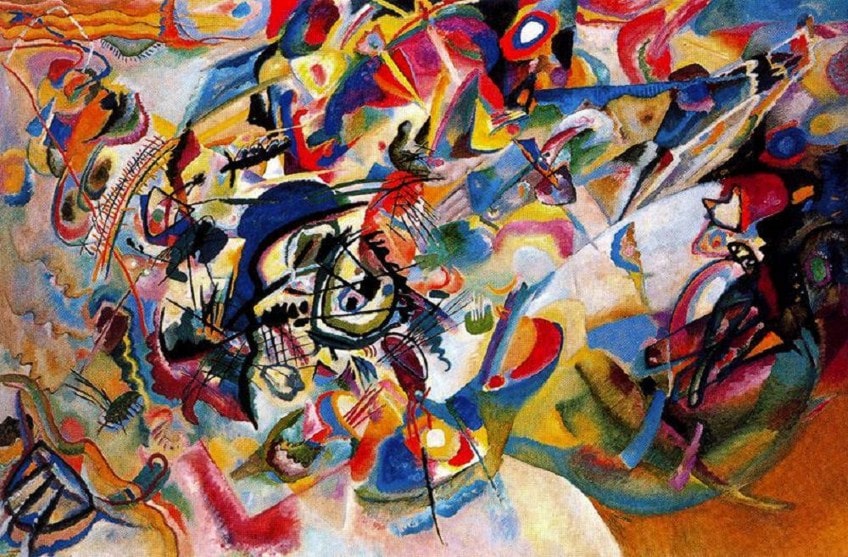 Composition VII (1913) past Wassily Kandinsky; Wassily Kandinsky, Public domain, via Wikimedia Commons
Composition VII (1913) past Wassily Kandinsky; Wassily Kandinsky, Public domain, via Wikimedia Commons
He explored the deeper meanings of color in art and how it communicated more spiritually, in his seminal publication, Concerning the Spiritual in Art (1912), he explored these concepts in more item, including comparing the use of color to music, but more broadly, the connection of art to music.
In his text, he explains how hands music expresses the inner world and how painters must "envy" this ease of expression.
Kandinsky started a serial of abstracts that conveyed this deeper spirituality, these were called his Improvisations, Compositions, and Impressions. An example of this is his Limerick VII (1913), which depicts an amalgamation of shapes and colors to the point where nosotros, the viewer, cannot recognize anything figurative or representational.
Another notable figure to mention in line with Non-Objective art is the Dutch Piet Mondrian. He was another leading pioneer in Abstract art during the 1920s. Relying on formal elements of lines and shapes he created non-objective paintings devoid of all recognizable representation. This simplicity of form too conveyed a deeper bulletin of underlying universal values.
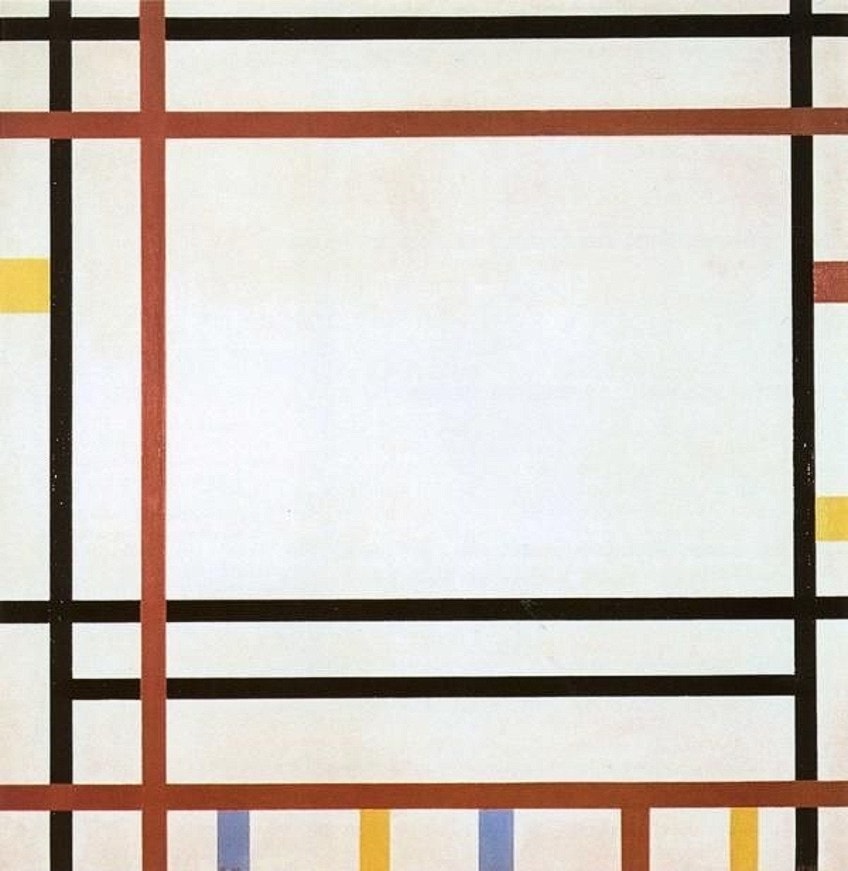 New York, New York (1942) by Piet Mondrian;Piet Mondrian, Public domain, via Wikimedia Commons
New York, New York (1942) by Piet Mondrian;Piet Mondrian, Public domain, via Wikimedia Commons
Mondrian likewise co-founded the De Stijl ("The Style") art movement with Dutch artist Theo van Doesburg. Within this motility, Mondrian founded Neo-Plasticism, in 1917, which sought to go back to nuts in art, so to say. This included depicting art in pure primal formal elements of color and lines, equally mentioned above.
Nevertheless, these were strictly horizontal and vertical lines along with correct angles, and the only colors used were primary colors, namely, cherry, blue, and yellow and neutral colors like white, gray, and black.
Michel Seuphor, in his publication, Piet Mondrian: Life and Work (1956), provided a quote by Mondrian who explains art'south relationship with reality, he says, "Fine art is college than reality and has no direct relation to reality". He further states that artists will need to use reality to the minimal extent because reality is opposed to the spiritual".
Neo-Plasticism was a radical art way and it aimed to depict an underlying harmony through fine art, this harmony was communicated in the most fundamental of shapes. Mondrian too wrote the essay titled, Neo-Plasticism in Pictorial Art (1917 to 1918), published in the De Stijl journal (likewise referred to as the De Stijl magazine by some sources).
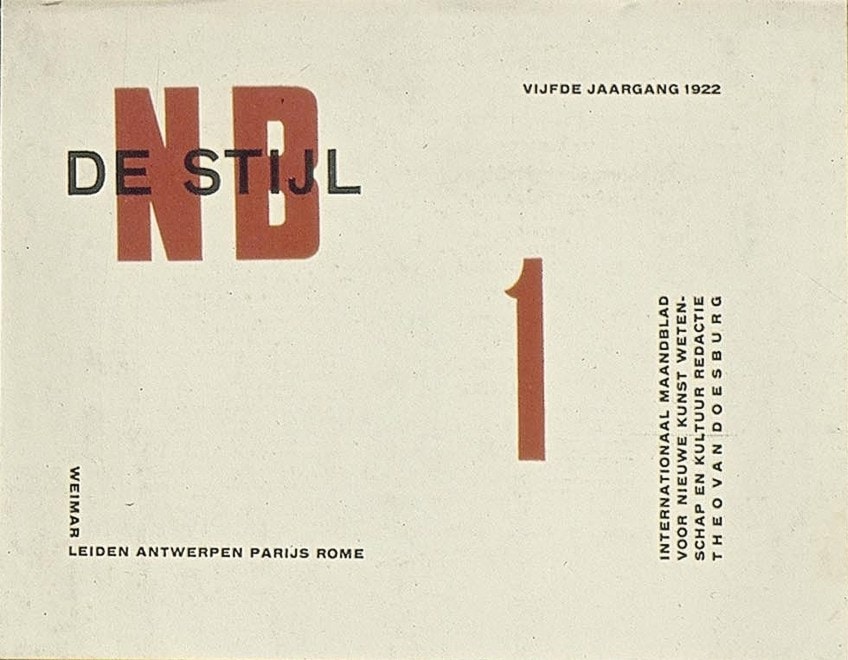 The cover of the De Stijl journal, vol. 5, no. 1, 1922;Theo van Doesburg, Public domain, via Wikimedia Eatables
The cover of the De Stijl journal, vol. 5, no. 1, 1922;Theo van Doesburg, Public domain, via Wikimedia Eatables
In his seminal essay he explained what Neo-Plasticism aimed to achieve, stating: "As a pure representation of the man heed, art will limited itself in an aesthetically purified, that is to say, abstract grade. The new plastic idea cannot, therefore, take the grade of a natural or physical representation". Furthermore, art will become well-nigh the "abstraction of form and color".
Van Doesburg somewhen broke away from Neo-Plasticism and started the style called Elementarism. This went confronting Mondrian's theories of strictly vertical and horizontal lines and included diagonal lines and tilted canvases. Information technology was more than dynamic than the more purist-driven ideals underpinning Neo-Plasticism. Some of the other Non-Objective art movements included the famous Cubism and Futurism, during the early 1900s, which were, in fact, large influencing movements on many 20th-century artists.
Orphism, also referred to equally Orphic Cubism, started in 1912. This was an of import art style that introduced the not-objective into the art earth.
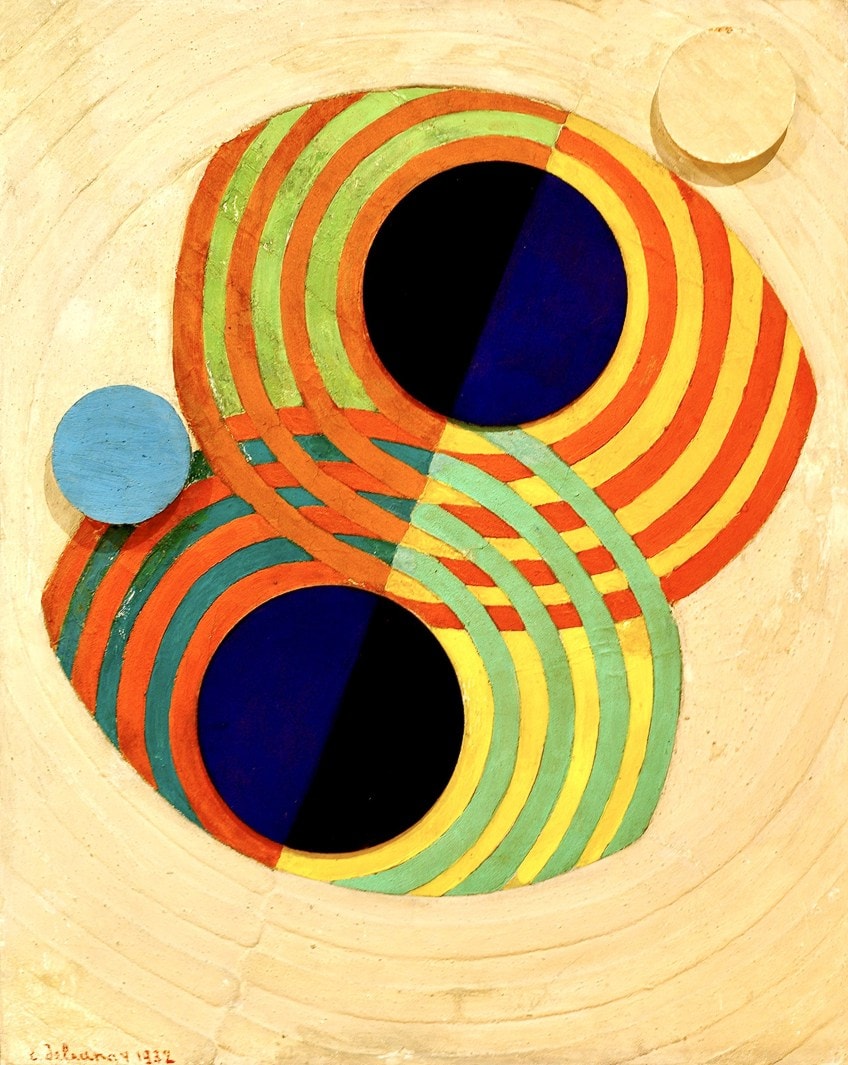 Relief, Rhythms (1932) past Robert Delaunay;Pedro Ribeiro Simões from Lisboa, Portugal, CC BY 2.0, via Wikimedia Eatables
Relief, Rhythms (1932) past Robert Delaunay;Pedro Ribeiro Simões from Lisboa, Portugal, CC BY 2.0, via Wikimedia Eatables
Information technology was started as a response to Analytical Cubism by Sonia and Robert Delaunay and František Kupka. The motility focused on including brighter colors and forms into abstracted compositions that appealed to the senses; artists drew inspiration for the utilize of bright colors from the Fauvist art movement. The name "Orphism" was given by the Frenchman Guillaume Apollinaire, who was an art critic and writer.
If we look at the work from the earlier Belittling Cubism, which was effectually 1910 to 1912, and led by Pablo Picasso and Georges Braque, subject matter like portraits or still lifes became highly fractured into semi-abstract compositions.
The film planes became multi-faceted and field of study affair viewed from multiple perspectives all on ane canvas. It was an art manner focused on deconstructing the picture plane and overlapping the resulting fragments. This importantly became so bathetic that it became almost completely not-objective art.
At that place was not a large emphasis on bright colors in Analytical Cubism, artists utilized subdued or monochromatic palettes similar browns, grays, ochres, blacks, and whites. The structural composition was the focal point of the paintings and there was no need to convey an emotion or symbolic meaning. Orphism, therefore, approached art differently and relied on colour and overlapping picture planes as we run across from Cubism.
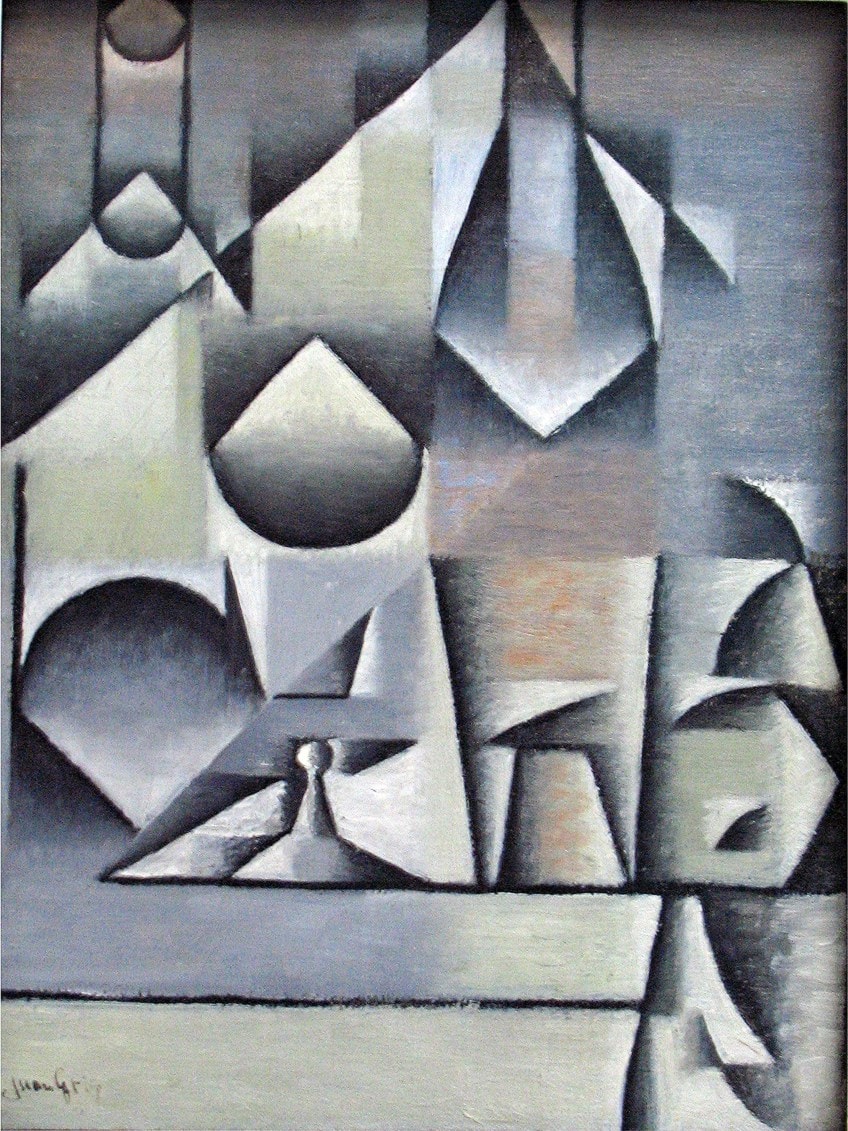 Glass and Bottles (1912) by Juan Gris;Juan Gris, Public domain, via Wikimedia Eatables
Glass and Bottles (1912) by Juan Gris;Juan Gris, Public domain, via Wikimedia Eatables
Other Non-Objective art movements towards the afterward 1900s include Hard-Edge Painting, which started during 1959 when the art critic Jules Langsner organized an fine art exhibition, the Four Abstract Classicists (1959), displaying the geometric abstract work of four artists from California at the Los Angeles County Museum of Fine art.
The artworks appeared similar that of Piet Mondrian'due south grids and squares with the deeper colors that we meet from the Color Field Painting style, which was a substyle of Abstract Expressionism. Well-known artists from the Colour Field Painting style were Marking Rothko and Barnett Newman. What characterized the in a higher place-mentioned Californian artists was their impersonal arroyo to depicting form and color.
Frank Stella was another notable Hard-Edge painter and created compositions that focused on the formal elements of fine art, like color, line, and course.
He became known for his impersonal paintings, specifically his Black Paintings series (1958 to 1960). What made Stella unlike from artists like Piet Mondrian, for example, was that he did non accept an intention to convey a deeper spiritual message through geometric abstraction. 1 of Stella's famous quotes is, "What you lot meet is what you see".
There was also no inherent deeper meaning every bit nosotros may meet from the gestural Action painting fashion, in the work of artists similar Jackson Pollock, for case. Additionally, Difficult-Edge Painting artists created clean and neatly structured compositions with almost no hint of brushstrokes, and their shapes appeared hard with "precipitous" edges. They were also influenced past the concept of unitary compositions.
Mail-Painterly Brainchild started during the 1950s, it was used by the fine art critic and historian, Cloudless Greenberg, to name and curate an exhibition for diverse artists like Helen Frankenthaler and Morris Louis, all from dissimilar Abstract painting styles, including Hard-Border Painting, Color Field Painting, Colour Stain Painting, Lyrical Abstraction, Washington Colour Painters, Minimal Painting, and others.
It was a response and rejection of the previous Abstract Expressionism (also called Painterly Abstraction) move that Greenberg believed was too emotional and gestural. What characterized the Post-Painterly Abstraction style was the veer towards formal elements in art-making, for example, linear designs, color, and shape.
Non-Objective Art Examples
Information technology is important to annotation that one of the main underpinning characteristics of Non-Objective painting is the utilization of the formal elements of art. Formal elements of visual arts include lines, shapes, forms, colors, textures, space, value (contrast or luminosity). All these elements are combined to create the subject matter.
Below, we look at various Not-Objective painting examples from various artists across multiple art movements and styles.
It will clearly show the variety with which each creative person has painted, specifically driven past their own inner intentions and desires to create fine art. Let united states start at the earliest, the pioneer of Abstract fine art, Wassily Kandinsky.
Expressionism: Wassily Kandinsky (1866 – 1944)
Wassily Kandinsky'south Composition VII (1913) is a fine example of a non-objective painting. In it we see a colorful mixture of shapes and lines all on ane spatial expanse making upward the canvas. With Kandinsky's keen interest in music, we meet how his canvas becomes almost like a composed slice, the title also reminding us of this connection to music.
Kandinsky clearly orchestrated his colors and forms in this painting and our visual sense perceives in much the aforementioned way as our auditory sense would a composed song.
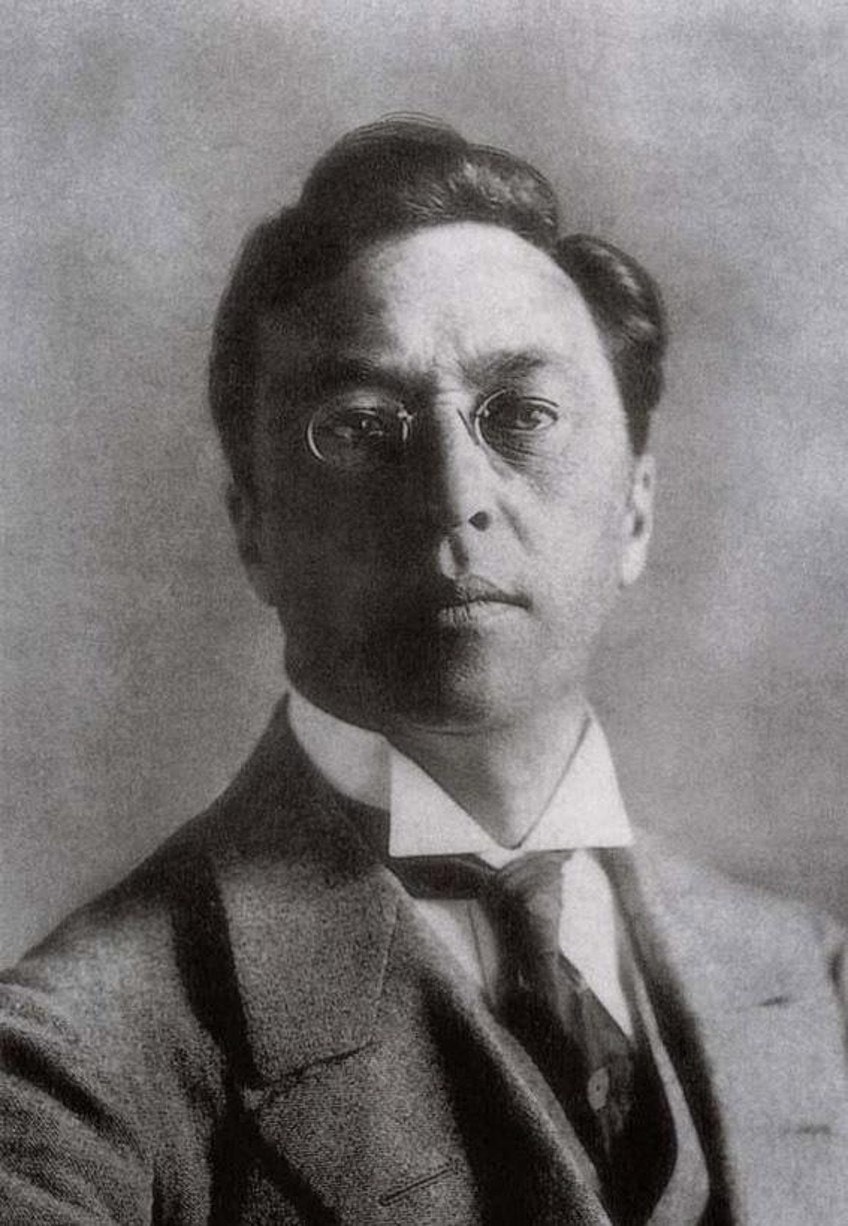 A photo of Wassily Kandinsky;未知上傳者, Public domain, via Wikimedia Commons
A photo of Wassily Kandinsky;未知上傳者, Public domain, via Wikimedia Commons
This is an example of how Kandinsky utilized the style of not-objective fine art and fastened a deeper symbolic significant to it too. For instance, he includes themes of the apocalypse and redemption by motifs like mountains, boats, and figures, but these are scarcely recognizable. The artists depicted these with reference to Biblical narratives similar the Garden of Eden and the Last Judgement.
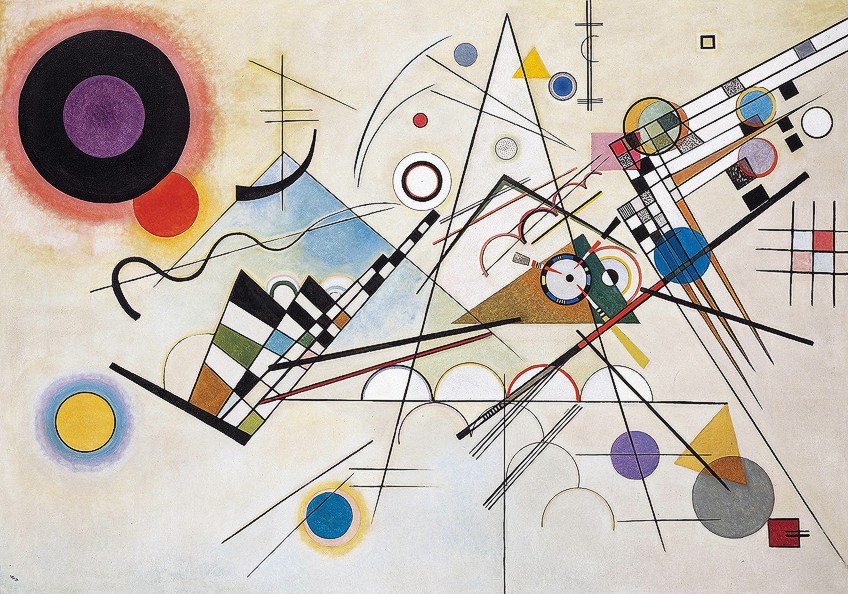 Composition III (1923) past Wassily Kandinsky;Wassily Kandinsky, Public domain, via Wikimedia Eatables
Composition III (1923) past Wassily Kandinsky;Wassily Kandinsky, Public domain, via Wikimedia Eatables
Other paintings past Kandinsky include Composition Viii (1923), which depicts how he incorporated aspects of Suprematism, Constructivism, and the Bauhaus School where he taught. This painting depicts Kandinsky'due south exploration of lines and shapes, something wholly dissimilar from his previous painting mentioned above. Hither it is an emphasis on form and not and then much color. Later paintings by Kandinsky include Several Circles (1926) and Composition X (1939).
Suprematism: Kazimir Malevich (1879 – 1935)
Kazimir Malevich's Black Foursquare (c. 1915) simply depicts a black square on a white background. Presently the painting is cracked due to aging, however, at that place are other marks axiomatic on this painting, for case, brushstrokes and fingerprints. This painting has been likened to an icon of sorts of non-representational art, emphasizing its spiritual qualities.
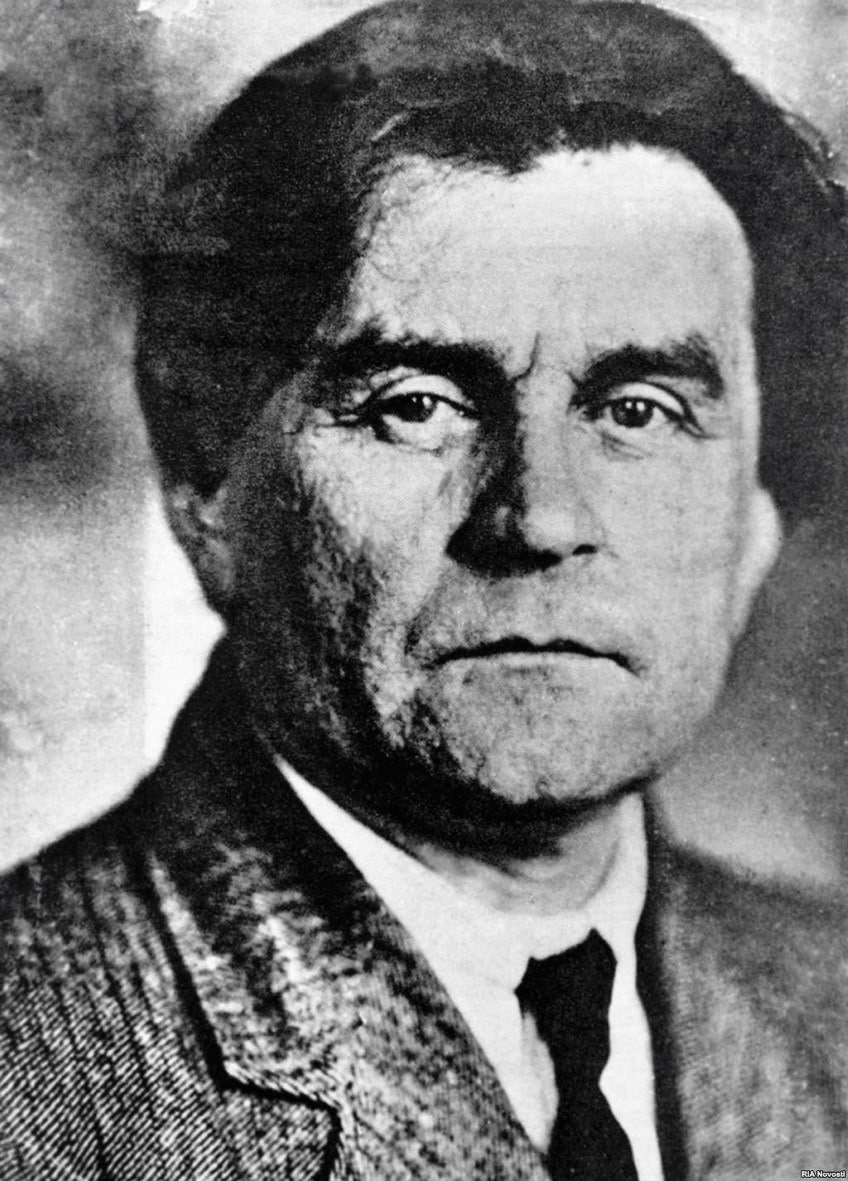 Kazimir Malevich, earlier 1935;Unknown author Unknown author, Public domain, via Wikimedia Eatables
Kazimir Malevich, earlier 1935;Unknown author Unknown author, Public domain, via Wikimedia Eatables
There are diverse other means nosotros can wait at this painting apart from it being an "iconic" symbol. Information technology is versatile to the viewer's perspective. The simplicity of the shape and no other accompanying shapes or colors as well creates a focal point for usa, the black square, with no other distractions.
A fun fact virtually this painting is that information technology was initially part of Malevich'due south sketch, in 1913, for a stage pall for the opera called "Victory Over the Sunday" (1926).
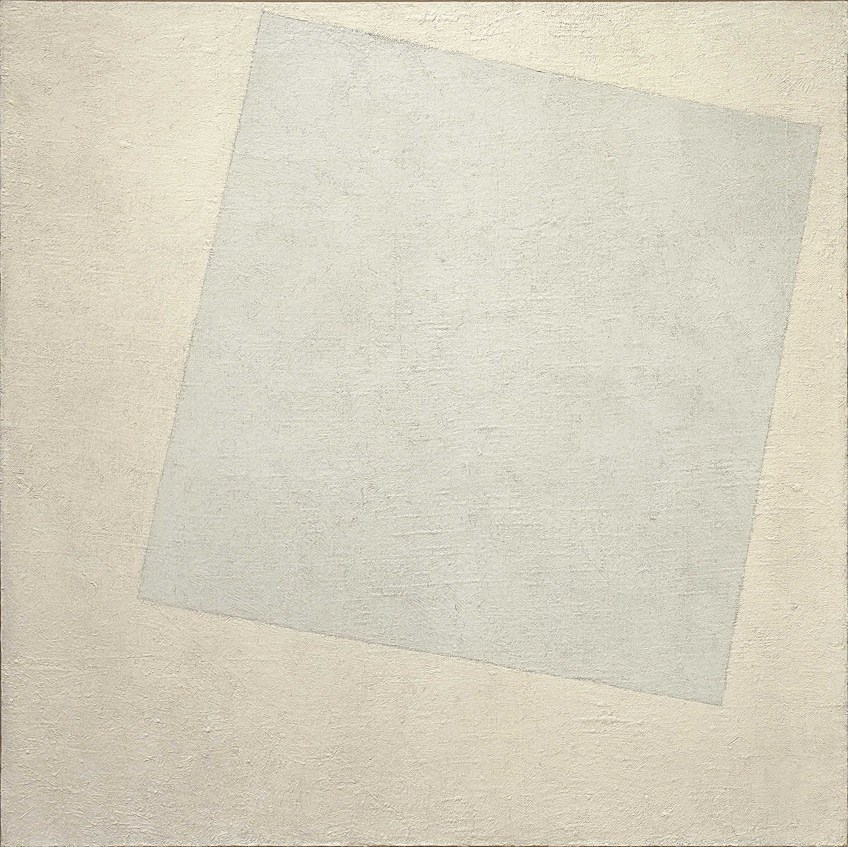 White on White (1918) by Kazimir Malevich;Kazimir Malevich, Public domain, via Wikimedia Commons
White on White (1918) by Kazimir Malevich;Kazimir Malevich, Public domain, via Wikimedia Commons
Other artworks past Malevich include Airplane Flying (1915), White on White (1917 to 1918), Painterly Realism of a Male child with a Knapsack. Color Masses in the Fourth Dimension (1915), and Painterly Realism of a Peasant Adult female in Two Dimensions (Red Square) (1915).
Neo-Plasticism: Piet Mondrian (1872 – 1944)
Piet Mondrian'due south compositions from the Neo-Plasticism way are examples that visually emulate not-objective art. If we await at his painting called Composition with Large Red Aeroplane, Yellow, Black, Gray, and Blue (1921) we see the fundamental foursquare and rectangular shapes with thick black outlines. The colors are express to scarlet, yellowish, blue, and white with areas of gray. It is a simple rendering of formal elements of vertical and horizontal lines, which ultimately make squares and rectangles.
Furthermore, the blocks are asymmetrical, we see the large red square in the center and surrounding smaller blocks.
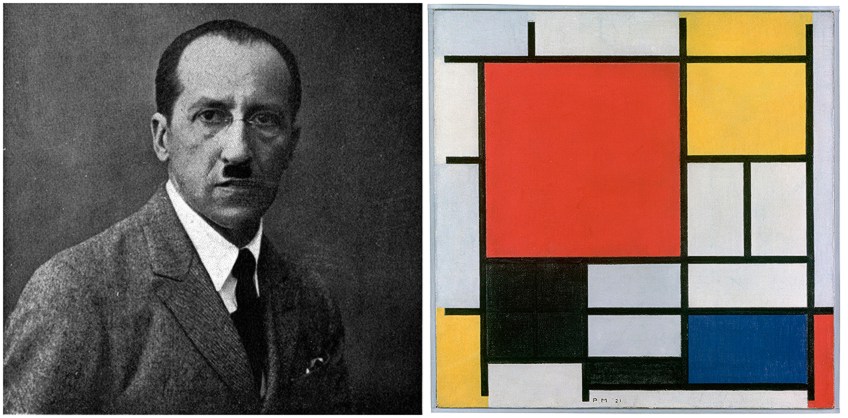 LEFT: A photo of Piet Mondrian from De Stijl, vol. five, no. 12 (Dec 1922): p. 179.; Anonymous (photographer), Public domain, via Wikimedia Commons | Correct: Composition with Large Red Plane, Xanthous, Black, Gray, and Blue (1921) by Piet Mondrian; Piet Mondrian, Public domain, via Wikimedia Eatables
LEFT: A photo of Piet Mondrian from De Stijl, vol. five, no. 12 (Dec 1922): p. 179.; Anonymous (photographer), Public domain, via Wikimedia Commons | Correct: Composition with Large Red Plane, Xanthous, Black, Gray, and Blue (1921) by Piet Mondrian; Piet Mondrian, Public domain, via Wikimedia Eatables
Nosotros volition encounter this style varied in numerous other paintings by Mondrian, some will have different-sized squares and others will emphasize more thick blackness outlines. Examples include Composition with Colour Planes (1917), Tableau I: Lozenge with Four Lines and Gray (1926), Composition 2 in Scarlet, Blue, and Yellow (1930), Limerick No. 10 (1939 to 1942), and Broadway Boogie-Woogie (1942 to 1943).
Orphism: Sonia Delaunay (1885 – 1979)
Sonia Delaunay was also involved in fashion, textile, and fix design and she eventually incorporated a lot of her work into functional forms like furniture, wall coverings, and clothing. Along with her husband, Robert Delaunay, the couple co-founded the Orphism fine art fashion. Orphism was characterized past deep colors and shapes, and we see this exemplified in Delaunay'southward various paintings.
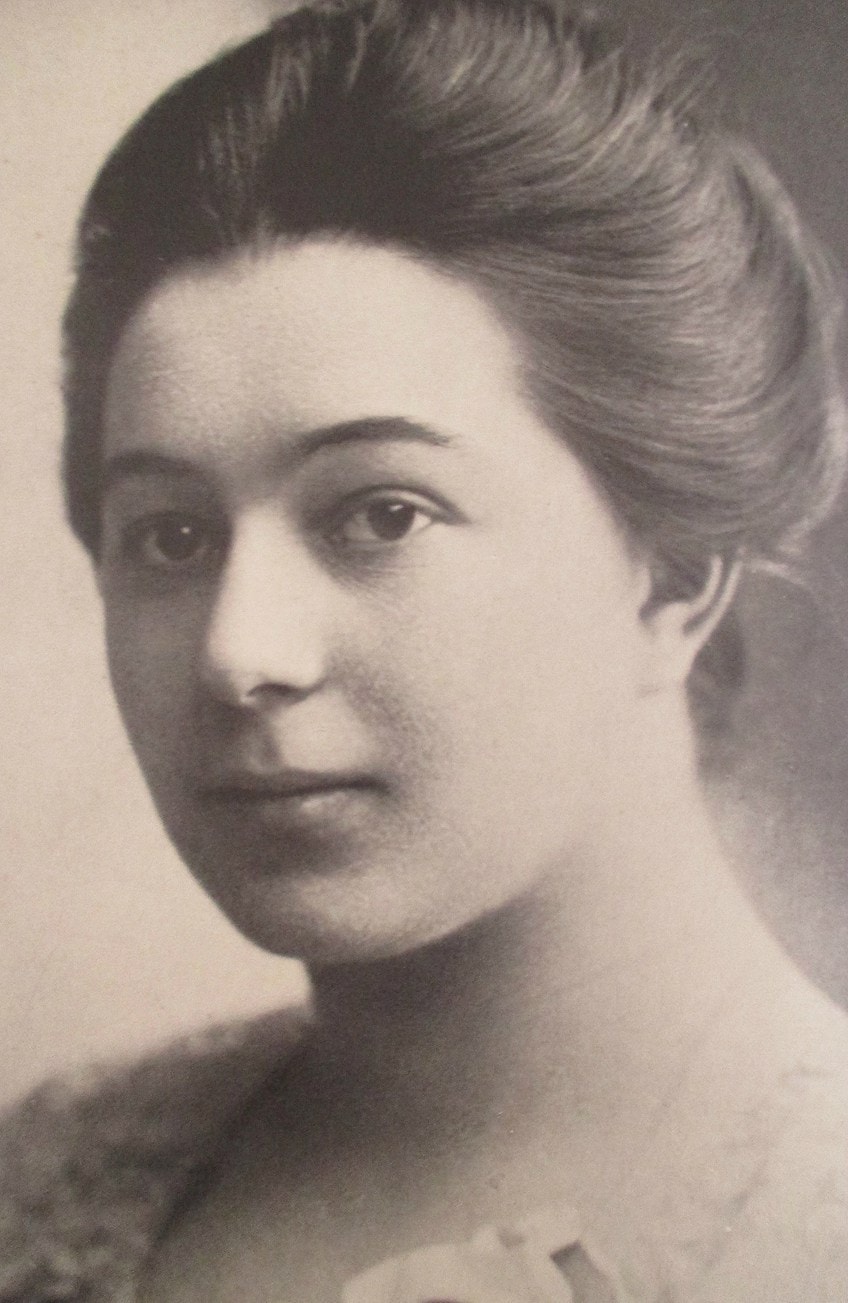 A portrait photo of Sonia Delaunay, c. 1912;Anonymous Unknown author, Public domain, via Wikimedia Commons
A portrait photo of Sonia Delaunay, c. 1912;Anonymous Unknown author, Public domain, via Wikimedia Commons
Some examples include Prismes électriques (Electric Prisms) (1914), which depict various circular and biconvex shapes. The primal surface area of the canvas has two larger circles and surrounding these are arcs, curves, and more than geometric shapes similar rectangles. The entire picture plane is multicolored.
The inspiration backside Delaunay'southward electric prisms were the electric streetlights of the streets of Paris.
While Sonia endeavored to reproduce the glow created by streetlights, her married man, Robert Delaunay, endeavored to similarly reproduce the effects of the Sun and Moonlight in his work Simultaneous Contrasts: Sun and Moon (1912).
Hard-Edge Painting: Frank Stella (1936 to Nowadays)
Frank Stella is a multi-talented creative person, he is a sculptor, printmaker, and painter. His artwork has delved in and out of many art styles, most notably that of Minimalism. We volition come across many of his artworks appear not-objective, not representing anything simply what is there, an example of this is from his Black Paintings series (1958 to 1960), The Marriage of Reason and Squalor, II (1959). Here nosotros see a black sail with nothing else but lines geometrically aligned with one some other; these have been described as "inverted parallel U-shapes".
Furthermore, there is no extensive indication of brushstrokes, and the work comes across as devoid of any figuration or reference to any other significant or symbols.
What we see really is what we encounter here. The painting has also been explained as not trying to create an "illusionistic" three-dimensional space that we have all come to understand from paintings, especially if we use the Renaissance as an example, the opposite of what non-objective art is.
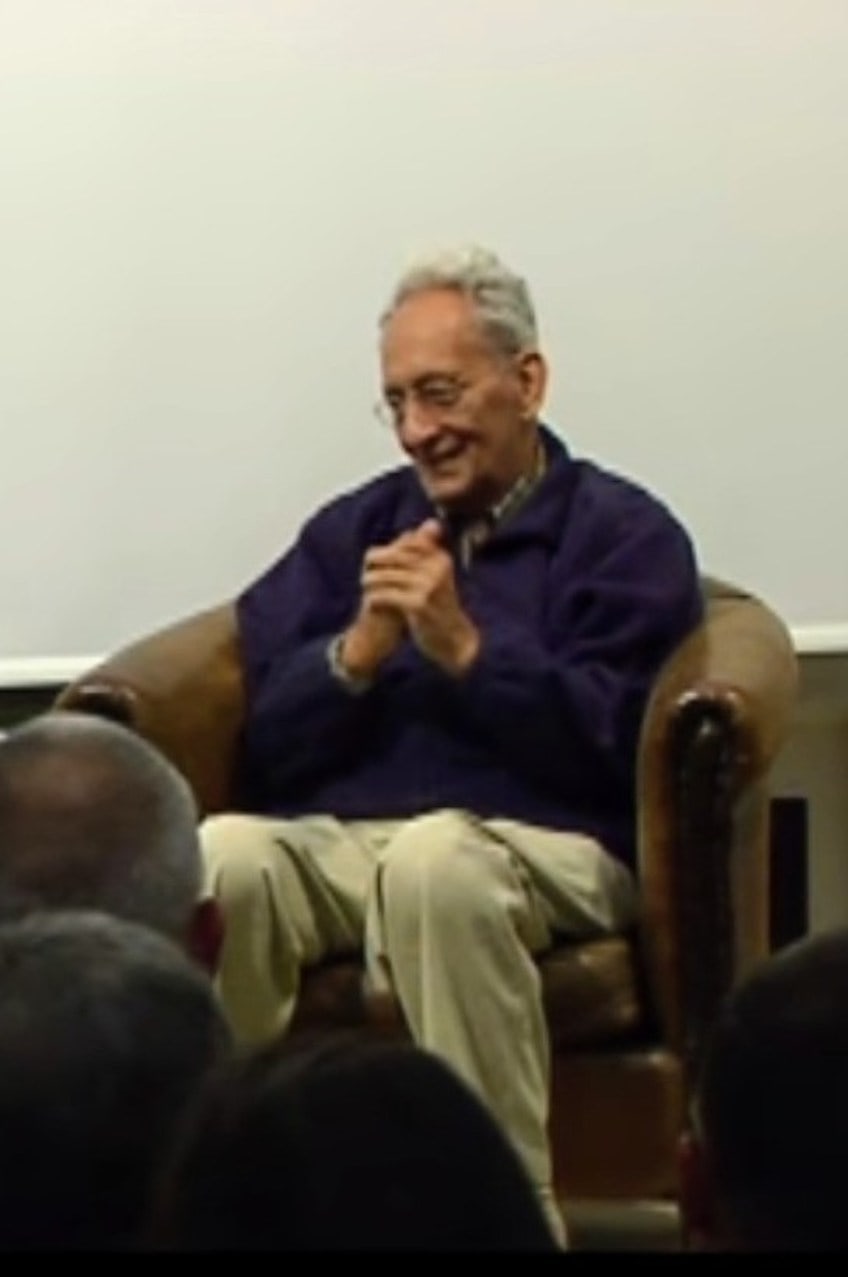 Frank Stella on the occasion of the exhibition "Frank Stella – The Retrospective. Works 1958 – 2012," at the Kunstmuseum Wolfsburg. The American Academy in Berlin hosted a chat between Stella and Hanno Rauterberg of Die Zeit on the distinctive and groundbreaking work of the renowned American artist;American University in Berlin, CC Past 3.0, via Wikimedia Commons
Frank Stella on the occasion of the exhibition "Frank Stella – The Retrospective. Works 1958 – 2012," at the Kunstmuseum Wolfsburg. The American Academy in Berlin hosted a chat between Stella and Hanno Rauterberg of Die Zeit on the distinctive and groundbreaking work of the renowned American artist;American University in Berlin, CC Past 3.0, via Wikimedia Commons
Stella'due south Harran Two (1967) from his Protractor (the late 1960s) serial is another example but in this case, information technology is not monochrome, but multi-colored. 3 circular shapes grab our attention; however, the unabridged composition is slanted diagonally and the circular shapes are almost housed within superimposed rectangular shapes.
This piece measures 10 x twenty feet and its big scale emphasizes the outcome of the geometric and colorful shapes when standing in front of it, additionally, the flat two-dimensionality of the canvas becomes unavoidable. It is made from polymer and fluorescent polymer pigment.
A Matter of Formality
The subject field matter for Non-Objective painting has been utilized past many artists for many different purposes throughout the twentyth and 21st Centuries. For some artists, information technology has been to convey a deeper, spiritual meaning. For some, information technology has been to create dynamism and rhythm. For others, it has been to echo the flow of music and the meaning of combined colors to elicit an emotional response. For some others, it has simply been to convey a shape and color, a pattern and structure, aught more than.
The subject matter of most Not-Objective paintings has been a matter of mere formality, an assortment of lines, shapes, and colors, but any purpose these assortments accept served, information technology has not been in vain because Non-Objective art continues to create new dimensions, not only in our minds, but as well our environments, and sometimes, something does non have to mean anything.
Frequently Asked Questions
What Is Non-Objective Fine art?
Non-Objective art can be viewed from multiple perspectives. Some sources propose it is a form or manner within the category of Abstract art, others advise information technology is not synonymous with Abstract art, and others suggest it is Abstract art. Not-Objective art is besides chosen geometric brainchild. According to the definition provided past Tate, it is divers every bit "a blazon of abstruse fine art that is usually, but not ever, geometric and aims to convey a sense of simplicity and purity".
What Is the Departure Between Non-Objective Art and Abstract Art?
Not-Objective art vs Abstract art is better understood when nosotros look at how Abstruse art is defined, namely, as fine art "that does not attempt to stand for an accurate depiction of a visual reality but instead uses shapes, colors, forms, and gestural marks to achieve its effect". Not-Objective art is a class of Abstract art where in that location are no representational qualities or likenesses to reality, information technology is completely non-representational and that is why it is too referred to every bit geometric brainchild.
What Are Non-Objective Art Movements?
Non-Objective art fits under diverse Abstract art movements, therefore, it is not an fine art motion per se, but more like a type or style of Abstract art. Non-Objective art tin be institute in art movements like Expressionism, Suprematism, Constructivism, Cubism, Orphism, Rayonism, Difficult-Border Painting, Post-Painterly Brainchild, and others.
Source: https://artincontext.org/non-objective-art/
Postar um comentário for "Who Painted Some of the Very First Nonobjective Paitings in Art History"